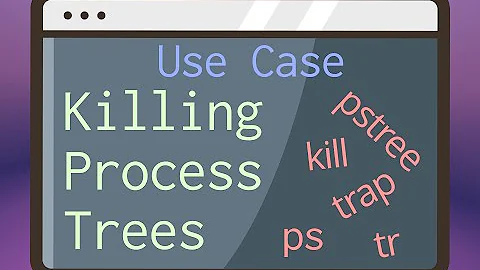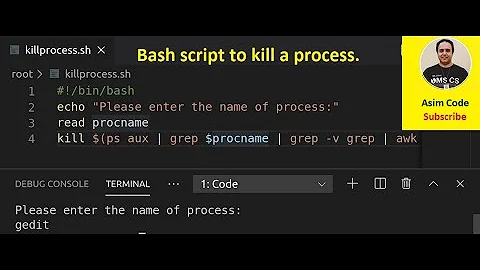Bash snippet for killing a process until it's dead?
Solution 1
The problem with repeatedly killing a process is that you've got a race condition with new process creation. It's not particularly likely, but it's possible that the process will exit and a new process start up with the same PID while you're sleeping.
Why are you having to repeatedly kill the process? If it's because the process will exit, but it may take some time to quit after receiving the signal, you could use wait:
kill $PID
wait $PID
In an ideal system, you'd never have to repeat a kill or issue kill -9 $PID. If you do have to, you might want to consider fixing whatever it is that you're running so you don't have to. In the meantime, you will probably not hit the race condition, and you can guard against it by (say) checking the timestamp of /proc/$PID/ just before killing the process. That's bad hackiness, though.
Solution 2
For everyone recommending the step from kill $PID to kill -9 $PID, I'd have to remind you of Useless use of kill -9.
No no no. Don't use kill -9.
It doesn't give the process a chance to cleanly:
shut down socket connections
clean up temp files
inform its children that it is going away
reset its terminal characteristics
and so on and so on and so on.
Generally, send 15, and wait a second or two, and if that doesn't work, send 2, and if that doesn't work, send 1. If that doesn't, REMOVE THE BINARY because the program is badly behaved!
Don't use kill -9. Don't bring out the combine harvester just to tidy up the flower pot.
Now, I don't agree with the "remove the binary part", but the progression seems less damaging than just a kill -9.
I also agree with the care about race conditions on the creation of new processes with the same PID mentioned here.
Related videos on Youtube
Araejay
Updated on September 17, 2022Comments
-
Araejay over 1 year
I'm trying to write a robust bash script, and in it I create a background process. At the end of the script, I want to kill it. I have it's PID.
I was thinking of somthing like this
while [[ ps ef $PID ]] ; do kill $PID sleep 0.5 doneAny suggests for anything better? Any possible problems with this approach?
-
 Admin almost 15 yearsDidn't you mean
Admin almost 15 yearsDidn't you meanps -ef? -
 Admin almost 15 yearsgrawity: Thats just BSD style vs UNIX options, but ef does seem to fit better with the UNIX options. I would go with 'ps ao pid' myself
Admin almost 15 yearsgrawity: Thats just BSD style vs UNIX options, but ef does seem to fit better with the UNIX options. I would go with 'ps ao pid' myself -
 Admin almost 7 years
Admin almost 7 yearswhile [[ ps ef $PID ]]is a syntax error. I assume you meantwhile ps ef $PID.
-
-
ktower almost 15 yearsBecause you want to give processes a chance to clean up and die nicely, which is what the TERM signal does (the default signal). The KILL signal ("-9") doesn't give processes that chance.
-
Axel almost 15 yearsAgreed. If it doesn't respond and close after one SIGTERM (the signal sent by default by kill) then is probably wont respond to a 2nd, 3rd, 4th, ...., so you next course of action should be SIGKILL (kill -9). Of course you should make sure that the X in "sleep X seconds" is long enough to allow the process to perform a normal clear-your-desk-and-leave operation even if the system is heavily loaded - it might take a fraction of a second normally but tens of seconds when the system is thrashing.
-
chris almost 15 yearsGood point, but the original poster did say he just wanted to kill it.
-
 Justin Force over 7 yearsThis doesn't work if the PID doesn't belong to a child process, i.e. this script is trying to control execution of a process that originated elsewhere. I get
Justin Force over 7 yearsThis doesn't work if the PID doesn't belong to a child process, i.e. this script is trying to control execution of a process that originated elsewhere. I getbash: wait: pid 32137 is not a child of this shellwhen i try. :(




